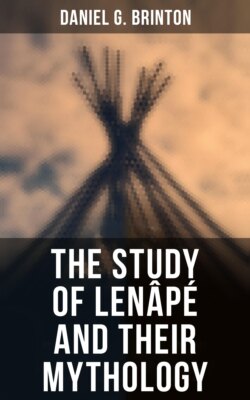Читать книгу The Study of Lenâpé and Their Mythology - Daniel G. Brinton - Страница 21
На сайте Литреса книга снята с продажи.
The Lenape Sub-Tribes.
ОглавлениеTable of Contents
The Lenape were divided into three sub-tribes:—
1. The Minsi, Monseys, Montheys, Munsees, or Minisinks.
2. The Unami, or Wonameys.
3. The Unalachtigo.
No explanation of these designations will be found in Heckewelder or the older writers. From investigations among living Delawares, carried out at my request by Mr. Horatio Hale, it is evident that they are wholly geographical, and refer to the locations of these sub-tribes on the Delaware river.
Minsi, properly Minsiu, and formerly Minassiniu, means "people of the stony country," or briefly, "mountaineers." It is a synthesis of minthiu, to be scattered, and achsin, stone, according to the best living native authorities.[54]
Unami, or W'nãmiu, means "people down the river," from naheu, down-stream.
Unalachtigo, properly W'nalãchtko, means "people who live near the ocean," from wunalawat, to go towards, and t'kow or t'kou, wave.
Historically, such were the positions of these sub-tribes when they first came to the knowledge of Europeans.
The Minsi lived in the mountainous region at the head waters of the Delaware, above the Forks, or junction of the Lehigh river. One of their principal fires was on the Minisink plains, above the Water Gap, and another on the East Branch of the Delaware, which they called Namaes Sipu, Fish River. Their hunting grounds embraced lands now in the three colonies of Pennsylvania, New York and New Jersey. The last mentioned extinguished their title in 1758, by the payment of one thousand pounds.
That, at any time, as Heckewelder asserts, their territory extended up the Hudson as far as tide-water, and westward "far beyond the Susquehannah," is surely incorrect. Only after the beginning of the eighteenth century, when they had been long subject to the Iroquois, have we any historic evidence that they had a settlement on the last named river.
The Unamis' territory on the right bank of the Delaware river extended from the Lehigh valley southward. It was with them and their southern neighbors, the Unalachtigos, that Penn dealt for the land ceded him in the Indian Deed of 1682. The Minsis did not take part in the transaction, and it was not until 1737 that the Colonial authorities treated directly with the latter for the cession of their territory.[55]
The Unalachtigo or Turkey totem had its principal seat on the affluents of the Delaware near where Wilmington now stands. About this point, Captain John Smith, on his map (1609,) locates the Chikahokin. In later writers this name is spelled Chihohockies, Chiholacki and Chikolacki, and is stated by the historians Proud and Smith to be synonymous with Delawares.[56] The correct form is Chikelaki, from chik'eno, turkey, the modern form as given by Whipple,[57] and aki land. The n, l and r were alternating letters in this dialect.
The population was, however, very sparse, owing to the predatory incursions of the Susquehannocks, whose trails, leading up the Octorara and Conestoga, and down the Christina and Brandywine Creeks, were followed by war parties annually, and desolated the west shores of the Bay and lower river. When, in 1634, Captain Thomas Young explored the river, the few natives he found on the west side told him (through the medium of his Algonkin Virginian interpreter) that the "Minquaos" had killed their people, burnt their villages, and destroyed their crops, so that "the Indians had wholly left that side of the river which was next their enemies, and had retired themselves on the other side farre up into the woods."[58]
North of the Chikelaki, Smith's map locates the Macovks. This name does not appear in later authors, but near that site were the Okahoki band, who occupied the shores of Ridley and Crum creeks and the land between them. There they remained until 1703, when they were removed to a small reservation of 500 acres in what is now Willistown township, Chester county.[59]
